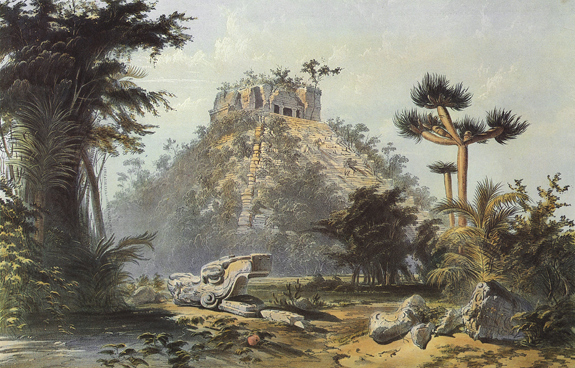
Drawing From the Past: Maya Antiquity Through the Eyes of Frederick Catherwood
Plate 22: Teocallis, at Chichén-Itzá
|
Plate 22, Teocallis, at Chichén-Itzá |
| Rising through a clearing in the jungle of the Yucatán, a monumental Maya pyramid appears to touch the sky in Catherwood’s illustration of the Pyramid of Kulkulcán. Although parts of the structure are covered in dense foliage, Catherwood has unveiled the pyramid’s most intriguing detail by bringing one of its many elaborate stone snakeheads to the foreground. This Maya pyramid is a nearly 80-foot, four-sided structure with a staircase on each side. Today it is known that it has two snakehead sculptures at the bottom of each staircase. On the equinoxes in September and March the sun casts a shadow that cascades down the 91 steps of the northern staircase, resembling the shape of an uncoiling serpent. Today, the ancient site still draws many fascinated tourists who admire this skillful tribute to Kulkulcán. The Maya worshipped a feathered serpent god Kulkulcán, or Quetzalcóatl. Legend claims that an ancient ruler, Kulkulcán, founded the Maya city of Chichén Itzá. There are several versions of this story. In one, it was said that the wandering founder was devoured by divine fire. His heart turned into the planet Venus and his ashes became birds. To honor this deity, the Maya built the serpent staircases with astounding precision. Catherwood accurately identified the pyramid’s religious framework by dramatically bringing the stone snakehead to the illustration’s foreground. [Spanish version]. DANIELLE GROGAN and SHU LIU |

